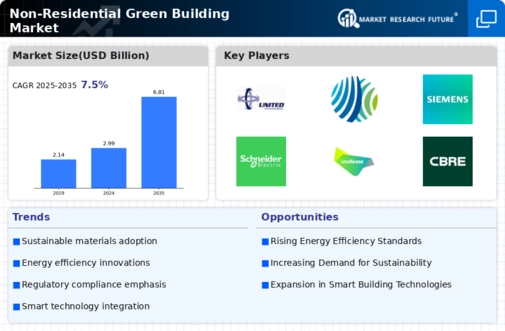Rising Energy Costs
The escalating costs of energy are compelling businesses to seek more efficient building solutions, thereby propelling the Non-Residential Green Building Market forward. As energy prices continue to rise, organizations are increasingly recognizing the long-term financial benefits of investing in energy-efficient buildings. According to recent data, energy-efficient buildings can reduce energy consumption by up to 30% compared to traditional structures. This reduction not only lowers operational costs but also enhances the overall value of the property. Consequently, the demand for green building technologies and practices is likely to increase, as companies aim to mitigate the impact of rising energy expenses on their bottom lines within the Non-Residential Green Building Market.
Technological Advancements
Technological innovations are playing a pivotal role in shaping the Non-Residential Green Building Market. The emergence of smart building technologies, such as IoT sensors and energy management systems, is enhancing the efficiency and sustainability of non-residential structures. These technologies enable real-time monitoring of energy usage, allowing for more informed decision-making regarding resource allocation. Furthermore, advancements in building materials, such as high-performance insulation and energy-efficient windows, are contributing to the overall sustainability of new constructions. As these technologies become more accessible and affordable, they are likely to drive further adoption of green building practices, thereby expanding the Non-Residential Green Building Market.
Corporate Sustainability Goals
Many corporations are establishing ambitious sustainability goals, which are significantly influencing the Non-Residential Green Building Market. As stakeholders demand greater accountability regarding environmental impact, businesses are increasingly committing to sustainable practices, including the construction of green buildings. A recent survey indicated that over 70% of large corporations have set targets for reducing their carbon footprints, which often includes investing in green building initiatives. This trend not only reflects a shift in corporate responsibility but also creates a robust market for green building materials and technologies. As companies strive to align their operations with sustainability objectives, the Non-Residential Green Building Market is poised for substantial growth.
Regulatory Support and Incentives
The Non-Residential Green Building Market is experiencing a surge in regulatory support and incentives aimed at promoting sustainable construction practices. Governments are increasingly implementing policies that encourage the adoption of green building standards, such as LEED and BREEAM. These regulations often come with financial incentives, including tax credits and grants, which can significantly reduce the initial costs associated with green building projects. For instance, in certain regions, buildings that meet specific energy efficiency criteria may qualify for reduced property taxes. This regulatory environment not only fosters innovation but also enhances the market's attractiveness to investors and developers, thereby driving growth in the Non-Residential Green Building Market.
Increased Awareness of Environmental Impact
There is a growing awareness of the environmental impact of construction practices, which is significantly influencing the Non-Residential Green Building Market. As climate change becomes an increasingly pressing issue, both consumers and businesses are prioritizing sustainability in their decision-making processes. This heightened awareness is leading to a demand for buildings that minimize ecological footprints and promote energy efficiency. Research indicates that buildings designed with sustainable practices can reduce greenhouse gas emissions by a substantial margin. Consequently, this shift in consumer preferences is driving the market towards greener alternatives, as stakeholders seek to align their operations with environmentally responsible practices within the Non-Residential Green Building Market.


















Leave a Comment